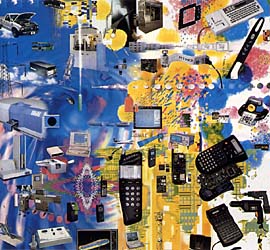| The Future 
One of the more
alarming predictions made at last year's
Photokina was the suggestion that by 1998, half
of us freelance photograpers would be out of work
as a result of digital technology. With 1998 also
being designated "The Year of Photography
and the Electronic Image", will it
unofficially become known as "The Year of
Digital Technology and the Unemployed
Photographer?" Mark Middlebrook of Silicon
Imaging (who we interviewed for the CD ROM)
thinks a more realistic prediction would be 35%
fewer freelance photographers in two to five
years time, but is at pains to point out that he
does not believe this necessarily means fewer
photographs will be used. Freelance photographic
businesses will diminish unless photographers are
prepared to adjust to the future trends in the
commissioning and purchasing of images. Our
industry is certainly facing a major shake-up as
a consequence of digital technology, but one can
forsee this creating new opportunities which will
enable photographers to diversify and carve out
new careers for themselves rather than become
redundant.
Contents
The production process is
no longer a linear chain of events - starting
with a photographer producing the photograph,
designer making a positional scan, laying out the
page and finally sending the artwork on disc and
original images to be re-scanned and assembled at
the printers. If the photographer shoots
digitally or supplies a digital file, this can
speed up the whole production process enormously.
In the past, services to the publishing /
advertising industries were clearly defined.
Everyone is now capable of using digital
technology in some form or other and each is
eager to defend their corner of the market. These
days, no single business is able to maintain a
monopoly on the type of service they provide,
because a consequence of the technology is that
we all have the means to do someone elses job.
Repro houses, still smarting from the loss of
their typesetting business to Mac-literate
designers are not keen to see their scanning
business disappear too. Photographer and
Association member Carl Lyttle, experienced this
stubbornness when recently supplying digital
files (with print proofs) ready to go to press.
He had endless problems thrown back at him by the
printers, who were clearly unwilling to
communicate the necessary information that would
have enabled Carl to get the files to them
correctly first time round. Much of the "I
know what I'm talking about more than you
do" posturing is a nervous reaction to an
uncertain future. Smart businesses will rise
above all this by adapting to change and working
together with us to produce the best work at the
most economical price. Although it is inevitable
we rub up against each other, we must deal with
this in a constructive not destructive way.
Alternatively, the designer may utilise a high
quality in house scanner suitable for repro
scanning and may wish to use the electronic tools
to create original artwork themselves.
Creative
control

This is a thorny issue for
photographers who are concerned about losing
creative control. Fran Evelegh used to rely
heavily on intricate darkroom and hand colouring
skills to produce her images. Then one year she
experienced a 50% drop in commissions and noticed
art directors requesting she supply unfinished
prints, so they could colour them in on the
computer themselves. Fran's response was to learn
Live Picture, and run it on the fastest Mac she
could lay her hands on. Her first major project
was a success - the story of how it comprised
over 900 separate layers still does the rounds
today, but the point is she recouped her
investment within 6 months and more importantly,
regained creative control of her images. Not only
that, but Fran now provides a corporate brochure
design service of her own which she is able to do
using her computer system. Business is not only
booming, but the approach she takes to her work
is more integrated and image led, which her
clients love.
In the future, it may become harder to define the
difference between a photographer and an
illustrator. We will see a greater diffusion
between the boundaries of photography,
illustration and graphic design. A few
Association members like Iain McKinnell, now
describe themselves as photo-illustrators.
British graphic design is the best in the world
and many designers incorporate their own
photographs or flat bed scan art techniques
within their typographic design. The pictures
chosen to illustrate this issue of Image
demonstrate the wide variety of ways that digital
technology can be applied to the image making
business: 3-D computer rendered images, digital
capture, photographers teaming up with computer
designers and people like Fran, who are clearly
au fait with the computer post-editing process.
Investment
Photographers will out of necessity have to
invest in digital equipment: Digital capture,
modem/ISDN connections, video conferencing
facilities and so on. As with all digital things,
performance goes up and prices are coming down.
But to keep ahead of the competition, the very
latest new technology will always come at a
premium price and studios will need to re-equip
every two years. The investment is going to be
beyond the means of most individual photographers
- the answer could be for photography businesses
to amalgamate and share the financial cost.
Pressure to do so will come from clients. Bates
Dorland advertising agency has invested in
digital technology. They are very aware of the
increased efficiency this offers and similarly
hope that the photographers they work with, will
equip themselves for the future and participate
at some, if not complete, digital level. In
Germany there is a catalogue company that
penalises photographers who are not able to
supply digital files as final artwork. Paul
Webster, who is Art Director of Sainsbury's
"The Magazine" is also gearing up his
magazine to require the same of the photographers
he commissions, because "it is going to make
my life a lot easier."
Photographers as a whole do not respond well to
such arm twisting tactics unless they can see a
logical reason to comply. People selling Digital
kit have often underestimated the cynicism of
photographers. Those who proudly claiming
"film is dead" probably once informed
you fibre base would die too with the advent of
resin coated paper. Of the limited number of
digital repro camera sales made in the UK so far,
few have gone to photographic studios. Most sales
have been to repro businesses, who are aiming to
provide an integrated service that will include
copying flat artwork and some product
photography. Companies such as these have
established links supplying repro services to
large organisations and are now seeking to expand
their range of services by offering digital
photography as an alternative to commisioning a
photographer shooting film. They are well able to
afford the high investment cost of digital
cameras and provide a faster and cheaper
photographic service to the client. But what
about the quality? That1s for the end client to
decide and it seems that some are happy to accept
lower standards at a cheaper price. Fusion (based
in Primrose Hill) provide an integrated design
service. Founded by Brian McMahon, a
photographer, all the production work at every
stage is carried out by a specialist in that
field: Photographers produce the photographs, and
designers take care of the production. Vincent
Flynn of Colour Solutions is also of the opinion
that companies adopting the Jack of all trades
approach will not survive. In the long run, there
will be a trend towards employing skilled
photographers to shoot digitally on a permanent
or freelance basis.
One obvious change that most of our members will
be aware of, is the growth of stock photography
usage, including royalty free CD libraries. The
Internet has proven a useful marketing tool of
stock images. In the United States over 50% of
screen based image purchases are made on the Net.
So we are seeing more photographers selling their
work through picture libraries and consequently
the standards required of submissions are much
higher than say a few years ago. The Internet may
further this trend for screen based image buying
if the bandwidth can be increased to make the
process faster. ie: we all want free ISDN
connections (or anything else that will speed up
the transfer of data). Though the more popular
the net becomes, the slower it gets. But, in
theory if you could access a preview of any image
anywhere in the world with a powerful search
engine, quickly, just think of the implications!
Implications
for the future
Does any of this really affect us? The low to
middle range of the market should be most
concerned - especially product shot photographers
. Those who work at the top end, may continue to
choose to use whatever means they like to achieve
the results seen in the portfolio. If your style
of work can only be achieved by soaking prints in
a bath of strong Darjeeling, then carry on doing
so. Good art directors will be guided by the
photographer and allow them to decide which
techniques they need to employ and clients will
have to accept the photographers judgement on
these matters as to whether film or digital is
best. At the very least, it will soon be
imperative for every photographer to install a
computer with a colour flatbed scanner hooked up
to the Internet via a modem connection, just as
we all need to have a fax to communicate with our
clients.
Film is here to stay for a long time especially
for fashion and portraiture, until digital
technology can match what we have now in terms of
speed and portability. As Chris Jackson of Metro
says, "if all the world knew was digital and
suddenly film was invented, we'd all think it was
amazing - 2 gigabytes of storage in a £4.00 box!
Trying to make direct comparisons between the two
mediums is daft". Nevertheless, Metro and
all the other major lab bureaux (as we should now
refer to them) are well prepared for the future
and ready to cater for the changes required to
adopt digital. Mark Middlebrook points out that
photographers are actually in a very good
position to gain - An awful lot of business still
stems from the photography process, the labs, the
bureaux and scanning services. the key is for
photographers to grasp hold of their true
strengths as producers and creative image makers.
They have the potential to maintain their share
of the business and more by adapting to new
techniques and leading the way rather than
playing wait and see.
Endnote
Wandering down Regents Canal the other day, I
spotted the derelict Gainsborough Studios, where
many classic fifties British movies such as
"The Lady killers" were once made. The
decline of Gainsborough and other British film
studios came about with the advent of television
broadcasting. I think one can draw an interesting
parallel here with what is happening today. The
cinema industry shrank due to the success of TV,
but it survived with fewer people working
exclusively in film, whilst television took over
as the medium for documentary and mass
entertainment. I don't suppose anyone then could
have foreseen exactly how far the television
market would expand, nor do I suppose they would
have believed that one day documentaries could be
made by a lone amateur using a DVC broadcast
quality camcorder! More films (TV and cinema) are
made today globally than ever before. New media
have expanded the accessibility of the tools with
which to communicate and everyone has had to
adapt to new working practices.
Digital technology has the potential to speed up
the production process, time and money can be
saved by taking full advantage of electronic
communications. As with the cinema industry, it
is not going to be the photographers who decide
whether digital technology has a future or not -
it will be the people buying our services.
Martin Evening 1996
martin@evening.demon.co.uk
|